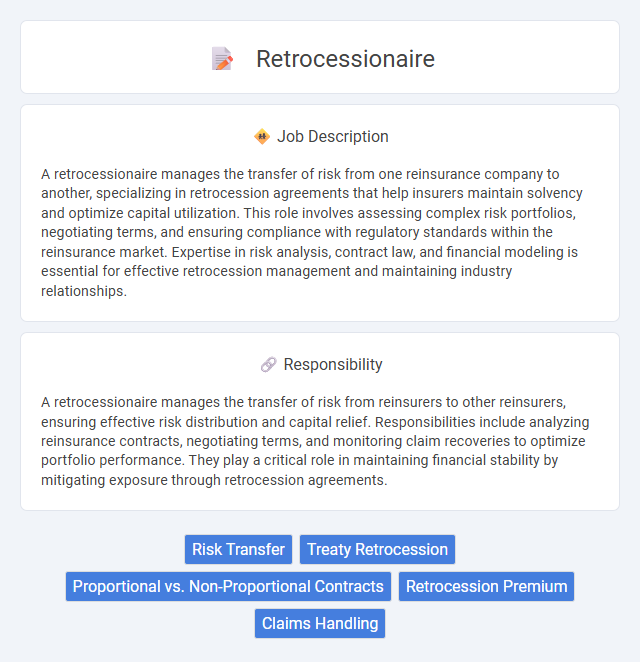
A retrocessionaire manages the transfer of risk from one reinsurance company to another, specializing in retrocession agreements that help insurers maintain solvency and optimize capital utilization. This role involves assessing complex risk portfolios, negotiating terms, and ensuring compliance with regulatory standards within the reinsurance market. Expertise in risk analysis, contract law, and financial modeling is essential for effective retrocession management and maintaining industry relationships.
Individuals with strong analytical skills and attention to detail are likely suitable for a retrocessionaire job, as it involves managing complex reinsurance contracts and assessing risk transfer. Those comfortable working in highly regulated environments with frequent data analysis and negotiation responsibilities may find the role fitting. However, people who struggle with precision or prefer less structured tasks might face challenges in adapting to this specialized position.
Qualification
A Retrocessionaire specializes in managing reinsurance risks by transferring portions of risk portfolios to other reinsurers, requiring expertise in actuarial analysis and risk assessment. Qualifications include a strong background in finance, insurance law, and data analytics, often supported by certifications such as Chartered Property Casualty Underwriter (CPCU) or Associate in Reinsurance (ARe). Proficiency in statistical modeling, negotiation skills, and knowledge of regulatory compliance are critical for ensuring effective risk mitigation and profitability.
Responsibility
A retrocessionaire manages the transfer of risk from reinsurers to other reinsurers, ensuring effective risk distribution and capital relief. Responsibilities include analyzing reinsurance contracts, negotiating terms, and monitoring claim recoveries to optimize portfolio performance. They play a critical role in maintaining financial stability by mitigating exposure through retrocession agreements.
Benefit
Working as a retrocessionaire likely offers significant financial benefits, including the potential for risk diversification and improved capital efficiency. This role may allow companies to transfer portions of their risk portfolios, which can lead to enhanced underwriting capacity and stability. Access to reinsurance market expertise and long-term partnerships might also contribute positively to profitability and business growth.
Challenge
A Retrocessionaire job likely involves navigating complex risk-sharing agreements, which presents ongoing challenges in accurately assessing and managing the transfer of risk between insurers and reinsurers. The role probably requires strong analytical skills to evaluate large volumes of data and predict potential financial exposures under various scenarios. Risk management in this context might be complicated by fluctuating market conditions and the need to balance profitability with regulatory compliance.
Career Advancement
A Retrocessionaire plays a critical role in managing reinsurance risk transfers between insurers and reinsurers, requiring expertise in risk assessment, contract negotiation, and financial analysis. Mastery of industry tools like actuarial software and strong analytical skills can lead to career advancement opportunities, such as senior risk analyst or reinsurance manager positions. Continuous professional development through certifications like the Chartered Property Casualty Underwriter (CPCU) enhances credibility and propels growth in this specialized insurance sector.
Key Terms
Risk Transfer
A Retrocessionaire specializes in risk transfer by assuming portions of reinsurance liabilities from primary reinsurers, thereby helping to distribute and mitigate large-scale financial exposure. This role is critical in the global insurance market, enabling risk diversification and capital relief for cedents through strategic retrocession agreements. Expertise in analyzing catastrophe models and underwriting complex reinsurance contracts drives effective risk allocation and financial stability within the retrocession market.
Treaty Retrocession
A Retrocessionaire manages treaty retrocession agreements by assuming risk transferred from a primary reinsurer, ensuring balanced risk distribution and capital management. Expertise in treaty retrocession is critical for evaluating complex risk portfolios, pricing, and negotiating terms that optimize financial exposure. Proficiency in regulatory compliance and actuarial analytics supports effective decision-making in retroceding premiums and claims liabilities.
Proportional vs. Non-Proportional Contracts
A Retrocessionaire manages risk by accepting portions of reinsurance contracts from primary reinsurers, specializing in both proportional and non-proportional contracts. Proportional contracts involve sharing premiums and losses in agreed proportions, whereas non-proportional contracts provide coverage only when losses exceed a predefined threshold, limiting risk exposure. Expertise in these contract types enables Retrocessionaires to optimize risk distribution and maintain capital efficiency in reinsurance markets.
Retrocession Premium
A retrocessionaire manages the risk transfer by accepting retrocession premiums from ceding reinsurers to assume a portion of their liabilities. The retrocession premium is a critical metric reflecting the cost and pricing of risk assumed in retrocession contracts, directly influencing profitability and capital allocation. Accurate assessment and optimization of retrocession premiums enable effective risk management and strengthen the reinsurer's financial stability.
Claims Handling
A Retrocessionaire specializes in managing reinsurance claims by assuming risk from ceding insurers, ensuring accurate evaluation and settlement of complex claims. Expertise in analyzing policy terms, loss adjustments, and timely communication with reinsurers is critical for efficient claims handling. Proficiency in data analytics and regulatory compliance significantly enhances the retrocessionaire's role in mitigating financial exposure and optimizing claim recovery processes.
 kuljobs.com
kuljobs.com